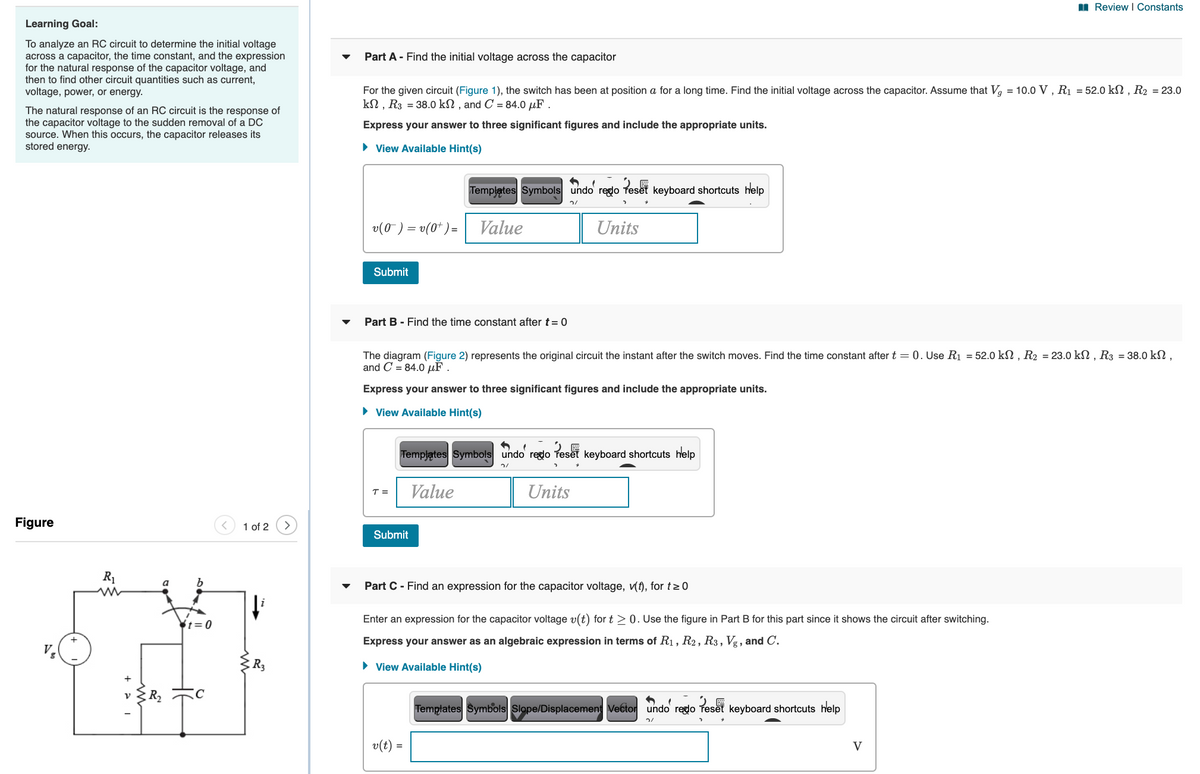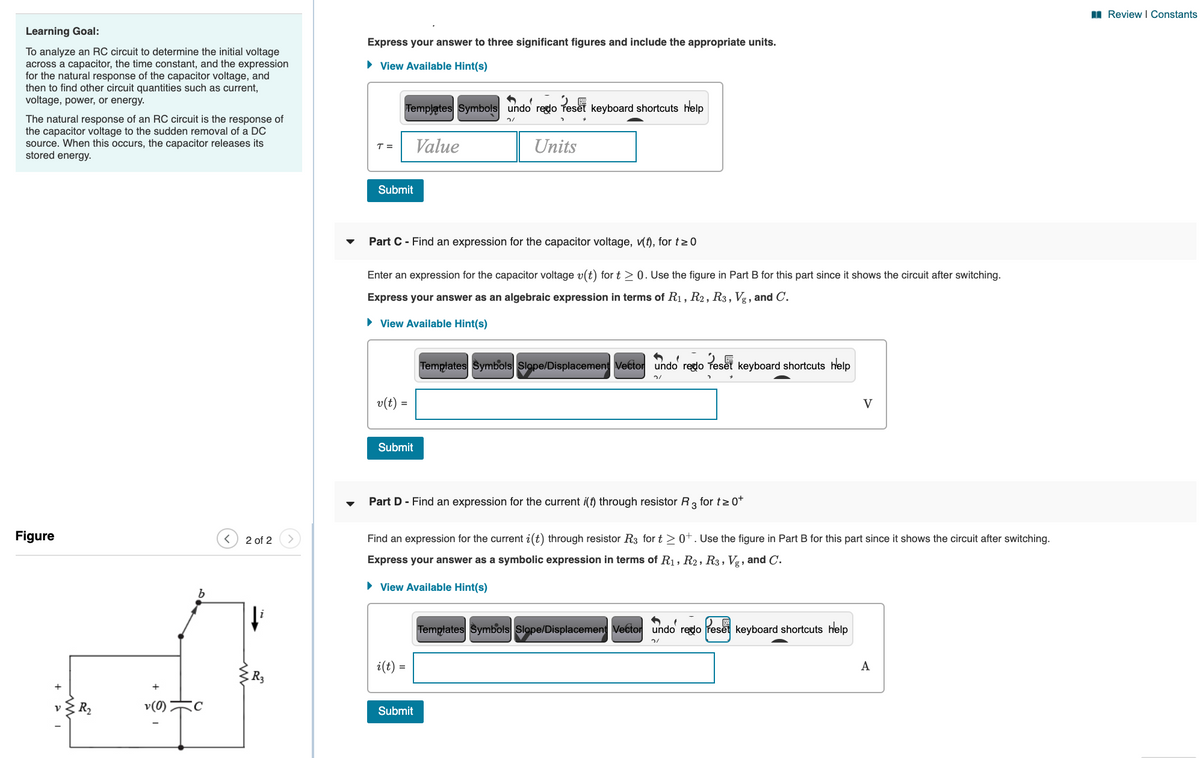To analyze an RC circuit to determine the initial voltage across a capacitor, the time constant, and the expression for the natural response of the capacitor voltage, and then to find other circuit quantities such as current, voltage, power, or energy. Part A - Find the initial voltage across the capacitor For the given circuit (Figure 1), the switch has been at position a for a long time. Find the initial voltage across the capacitor. Assume that V, = 10.0 V , R = 52.0 kn , R2 = 2 kn , R3 = 38.0 k2 , and C = 84.0 µF . The natural response of an RC circuit is the response of the capacitor voltage to the sudden removal of a DC source. When this occurs, the capacitor releases its stored energy. Express your answer to three significant figures and include the appropriate units. • View Available Hint(s) Tempjetes Symbols undo rego Teset keyboard shortcuts Help v(0 ) = v(0* ) = Value Units Submit Part B - Find the time constant after t= 0 The diagram (Figure 2) represents the original circuit the instant after the switch moves. Find the time constant after t = 0. Use Ri = 52.0 kn , R2 = 23.0 kn , R3 = 38.0 k and C= 84.0 juF. Express your answer to three significant figures and include the appropriate units. • View Available Hint(s) Templetes Symbols undo rego feset keyboard shortcuts help Value Units gure 1 of 2 > Submit R1 Part C- Find an expression for the capacitor voltage, v), for tz 0 =0 Enter an expression for the capacitor voltage v(t) for t > 0. Use the figure in Part B for this part since it shows the circuit after switching. Express your answer as an algebraic expression in terms of R1, R2, R3, Vg, and C. • View Available Hint(s) R Templates Symbols Slope/Displacemen Vector undo redo Teset keyboard shortcuts help v(t) = V
To analyze an RC circuit to determine the initial voltage across a capacitor, the time constant, and the expression for the natural response of the capacitor voltage, and then to find other circuit quantities such as current, voltage, power, or energy. Part A - Find the initial voltage across the capacitor For the given circuit (Figure 1), the switch has been at position a for a long time. Find the initial voltage across the capacitor. Assume that V, = 10.0 V , R = 52.0 kn , R2 = 2 kn , R3 = 38.0 k2 , and C = 84.0 µF . The natural response of an RC circuit is the response of the capacitor voltage to the sudden removal of a DC source. When this occurs, the capacitor releases its stored energy. Express your answer to three significant figures and include the appropriate units. • View Available Hint(s) Tempjetes Symbols undo rego Teset keyboard shortcuts Help v(0 ) = v(0* ) = Value Units Submit Part B - Find the time constant after t= 0 The diagram (Figure 2) represents the original circuit the instant after the switch moves. Find the time constant after t = 0. Use Ri = 52.0 kn , R2 = 23.0 kn , R3 = 38.0 k and C= 84.0 juF. Express your answer to three significant figures and include the appropriate units. • View Available Hint(s) Templetes Symbols undo rego feset keyboard shortcuts help Value Units gure 1 of 2 > Submit R1 Part C- Find an expression for the capacitor voltage, v), for tz 0 =0 Enter an expression for the capacitor voltage v(t) for t > 0. Use the figure in Part B for this part since it shows the circuit after switching. Express your answer as an algebraic expression in terms of R1, R2, R3, Vg, and C. • View Available Hint(s) R Templates Symbols Slope/Displacemen Vector undo redo Teset keyboard shortcuts help v(t) = V
Introductory Circuit Analysis (13th Edition)
13th Edition
ISBN:9780133923605
Author:Robert L. Boylestad
Publisher:Robert L. Boylestad
Chapter1: Introduction
Section: Chapter Questions
Problem 1P: Visit your local library (at school or home) and describe the extent to which it provides literature...
Related questions
Question
100%
Please help me with parts a, b, c, and d

Transcribed Image Text:I Review I Constants
Learning Goal:
To analyze an RC circuit to determine the initial voltage
across a capacitor, the time constant, and the expression
for the natural response of the capacitor voltage, and
then to find other circuit quantities such as current,
voltage, power, or energy.
Part A - Find the initial voltage across the capacitor
For the given circuit (Figure 1), the switch has been at position a for a long time. Find the initial voltage across the capacitor. Assume that V, = 10.0 V , R1 = 52.0 kN , R2 = 23.0
kN , R3 = 38.0 kN , and C = 84.0 µF .
The natural response of an RC circuit is the response of
the capacitor voltage to the sudden removal of a DC
source. When this occurs, the capacitor releases its
stored energy.
Express your answer to three significant figures and include the appropriate units.
• View Available Hint(s)
Templates Symbols undo redo Teset keyboard shortcuts help
v(0 ) = v(0* ) =
Value
Units
Submit
Part B - Find the time constant after t= 0
The diagram (Figure 2) represents the original circuit the instant after the switch moves. Find the time constant after t = 0. Use R1 = 52.0 kN , R2 = 23.0 kSN , R3 = 38.0 kN,
and C = 84.0 uF
Express your answer to three significant figures and include the appropriate units.
• View Available Hint(s)
Templątes Symbols undo reglo
Peset
keyboard shortcuts help
Value
Units
T =
Figure
1 of 2
Submit
R1
Part C- Find an expression for the capacitor voltage, v(f), for t>0
Enter an expression for the capacitor voltage v(t) for t > 0. Use the figure in Part B for this part since it shows the circuit after switching.
¥t=0
Express your answer as an algebraic expression in terms of R1, R2, R3, Vg , and C.
• View Available Hint(s)
Templates Symbols Slope/Displacement Vector undo reglo Teset keyboard shortcuts help
v(t) =
V

Transcribed Image Text:I Review I Constants
Learning Goal:
Express your answer to three significant figures and include the appropriate units.
To analyze an RC circuit to determine the initial voltage
across a capacitor, the time constant, and the expression
for the natural response of the capacitor voltage, and
then to find other circuit quantities such as current,
voltage, power, or energy.
• View Available Hint(s)
Templates Symbols undo rego
keyboard shortcuts help
The natural response of an RC circuit is the response of
the capacitor voltage to the sudden removal of a DC
source. When this occurs, the capacitor releases its
stored energy.
Value
Units
T =
Submit
Part C- Find an expression for the capacitor voltage, (f), for t>0
Enter an expression for the capacitor voltage v(t) for t > 0. Use the figure in Part B for this part since it shows the circuit after switching.
Express your answer as an algebraic expression in terms of R1, R2, R3, Vg , and C.
• View Available Hint(s)
Templates Symbols Slope/Displacement Vector undo reglo Teset keyboard shortcuts help
v(t) =
V
Submit
Part D - Find an expression for the current i(t) through resistor R, for t> o*
Figure
2 of 2
Find an expression for the current i(t) through resistor R3 for t>0+. Use the figure in Part B for this part since it shows the circuit after switching.
Express your answer as a symbolic expression in terms of R1, R2, R3, Vg, and C.
• View Available Hint(s)
Templates Symbols Slope/Displacement Vector undo reglo reset keyboard shortcuts help
i(t) =
A
R3
R2
Submit
Expert Solution
This question has been solved!
Explore an expertly crafted, step-by-step solution for a thorough understanding of key concepts.
This is a popular solution!
Trending now
This is a popular solution!
Step by step
Solved in 2 steps with 2 images

Knowledge Booster
Learn more about
Need a deep-dive on the concept behind this application? Look no further. Learn more about this topic, electrical-engineering and related others by exploring similar questions and additional content below.Recommended textbooks for you

Introductory Circuit Analysis (13th Edition)
Electrical Engineering
ISBN:
9780133923605
Author:
Robert L. Boylestad
Publisher:
PEARSON

Delmar's Standard Textbook Of Electricity
Electrical Engineering
ISBN:
9781337900348
Author:
Stephen L. Herman
Publisher:
Cengage Learning

Programmable Logic Controllers
Electrical Engineering
ISBN:
9780073373843
Author:
Frank D. Petruzella
Publisher:
McGraw-Hill Education

Introductory Circuit Analysis (13th Edition)
Electrical Engineering
ISBN:
9780133923605
Author:
Robert L. Boylestad
Publisher:
PEARSON

Delmar's Standard Textbook Of Electricity
Electrical Engineering
ISBN:
9781337900348
Author:
Stephen L. Herman
Publisher:
Cengage Learning

Programmable Logic Controllers
Electrical Engineering
ISBN:
9780073373843
Author:
Frank D. Petruzella
Publisher:
McGraw-Hill Education

Fundamentals of Electric Circuits
Electrical Engineering
ISBN:
9780078028229
Author:
Charles K Alexander, Matthew Sadiku
Publisher:
McGraw-Hill Education

Electric Circuits. (11th Edition)
Electrical Engineering
ISBN:
9780134746968
Author:
James W. Nilsson, Susan Riedel
Publisher:
PEARSON

Engineering Electromagnetics
Electrical Engineering
ISBN:
9780078028151
Author:
Hayt, William H. (william Hart), Jr, BUCK, John A.
Publisher:
Mcgraw-hill Education,